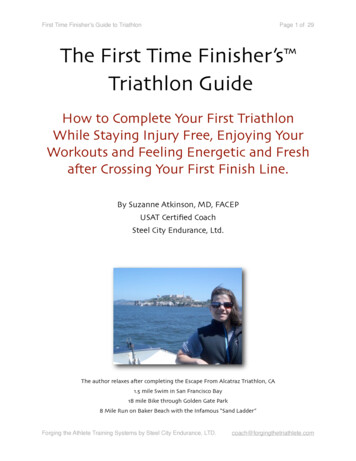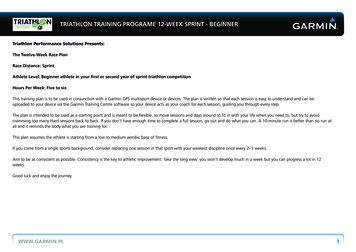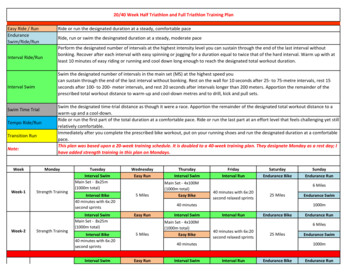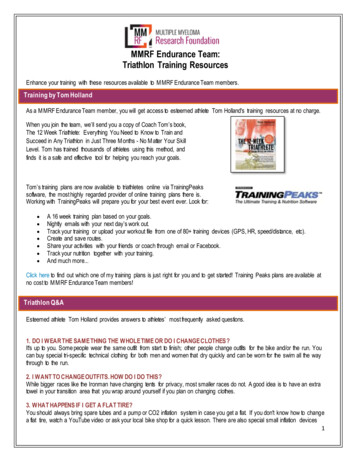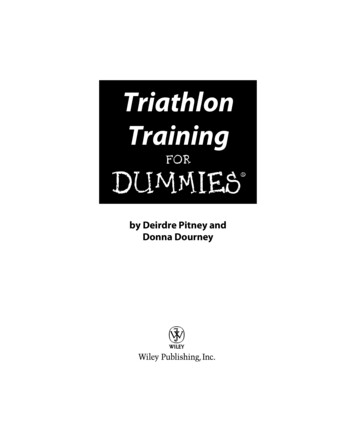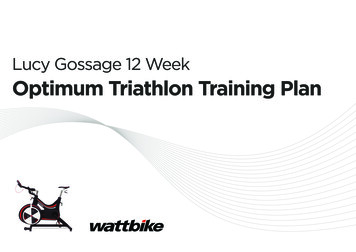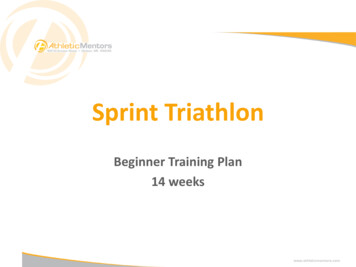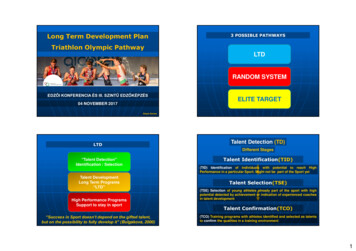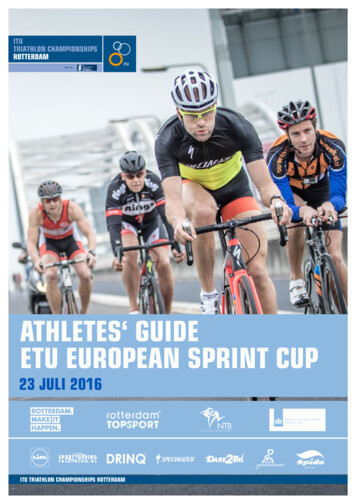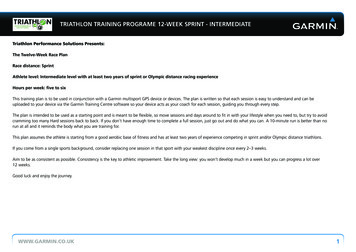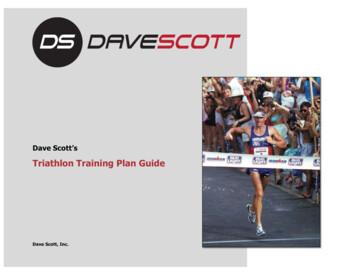
Transcription
Dave Scott’sTriathlon Training Plan GuideDave Scott, Inc.
Purpose of this GuideEvery tribe speaks its own language, and our tribe of triathlon has a unique vernacularand jargon that can, at times, be confusing.This Guide is designed to accompany one of Dave Scott’s 12-week training plans, and willhelp familiarize you with Dave’s training philosophy and decipher his terminology.Copyright 2018 by Dave Scott, Inc.i
Waiver of LiabilityNo expressed or implied warranty (whether of merchantability, fitness for a particularpurpose, or otherwise) or other guaranty is made as to the accuracy or completeness ofany of the information or content contained in this document. Dave Scott, Dave Scott,Inc. and Dave Scott Triathlon Club accept no responsibility and hereby disclaim allresponsibility for any loss or damage suffered as a result of the use or misuse of anyinformation or content or any reliance thereon. It is the responsibility of all users of thismaterial to satisfy themselves as to the medical and physical condition of themselves indetermining whether or not to use or adapt the information or content provided in eachcircumstance. Notwithstanding the medical or physical condition of each user, DaveScott, Dave Scott, Inc. and Dave Scott Triathlon Club accept no responsibility or liabilityand hereby disclaim all responsibility and liability for any loss or damage suffered by anyperson as a result of the use or misuse of any of the information or content in thisdocument. Dave Scott, Dave Scott, Inc. and Dave Scott Triathlon Club hereby expresslyexclude all liability for incidental and consequential damages.Be sure to check with your doctor prior to engaging in any rigorous physical training. Youare responsible for your own health!Copyright 2018 by Dave Scott, Inc.ii
Copyright2018 Dave Scott Inc. All rights reserved. No part of this work may be reproduced orused in any form or by any means without prior written permission from the author. Anyunauthorized transmission, either electronic or printed, is prohibited.Copyright 2018 by Dave Scott, Inc.iii
IntroductionFor more than 35 years I’ve had the privilege to coach and advise thousands of athletes,from novices to competitive age groupers to world champions, like Chrissie Wellingtonand Craig Alexander.I served as the national triathlon coach for Team in Training for more than a decade,where I taught both introductory and advanced techniques to TnT’s coaches. As a MasterCoach of IRONMAN U, I helped author its rigorous coaching certification program.I’m also the founder of the Dave Scott Institute, headquartered in Kailua-Kona andBoulder, CO, which produces cutting edge training methodologies and devises practicalsolutions for triathletes by utilizing the very latest science and research.My lifelong passion for coaching is reflected in everything I do.With this training plan, you gain access to my wide-ranging experience distilled downinto a single, targeted program. It will provide a systematic and progressive approach toyour weekly regimen to ensure incremental improvement and race day success I callthis The Dave Scott Method .While requiring your focus and commitment, this plan has been designed toaccommodate the occasional interruptions and detours that we all experience in ourhectic lives. If you can complete 70% to 85% of this training program, then you willachieve success. I guarantee it.I hope you enjoy the experience – good luck!Copyright 2018 by Dave Scott, Inc.1
Overview of Your Training PlanThis training plan incorporates a purposeful and progressive protocol that will guide youto your goal race.Development of your aerobic foundation is the backbone of any triathlon program, soyou will spend a great deal of time fortifying your aerobic “plumbing.” However, whileaerobic training makes up a large portion of the program, I’ve incorporated varyingworkload intensities to maximize your progress and “metabolic return”.These injections of “High Intensity Interval Training” -- or “HIIT” – will be the secret toyour success! They deliver a huge return, improve your training efficiency, and providepurpose to almost every session.Marker Sets will provide the opportunity to assess your improvement. I have integratedmarker sets at regular intervals within each training cycle. Recording your total distance,perceived exertion, speed, or power will allow you to evaluate and critique your progressthrough the plan. You may choose among a wide variety of tools to monitor yourprogress. If you want simplicity, then that is your choice. You can decide what tools workbest for you.Before performing a training session, refer to the workout description for details on whatthat workout entails. The workout jargon – and my sometimes cryptic abbreviations – isexplained in this training guide.Each workout may have a total time or total distance specified. This is only meant to bea reference. Keep in mind that every athlete is different so don’t worry if the total timeseems too much for the total distance (or vice versa) – just go by the workoutdescription.If a particular workout seems too difficult – or if you’re just feeling “off” on that day –then focus on completing the Warm-up and the Main Set.If you miss a day – and you inevitably will – don’t try to make it up. Just look ahead andkeep going.Copyright 2018 by Dave Scott, Inc.2
Understanding Training WorkloadsWorkload is the demand you place upon your body when exercising – often referred toas the “training zone.”“Specificity” is the exercise principle that states the type of demand placed on the bodydictates the type of adaptation that will occur. If you spend time training at a givenworkload (or in a specific training zone), then your body will adapt specifically to thatworkload. As triathletes, we want to appropriately stimulate our body to adapt to thedemands of our goal race.Here are the workloads found in my programs -- from lowest to highest intensity -and how they relate to your triathlon training.RecoveryVery, very light exercise. Workload is predominantly prescribed post race and/orrecovering from an injury or illness.Allowing your body adequate warm-up time, elevating the skin and core temperature,typically requires 8 to 20 minutes. The warm-up should reach 40 beats below LT beforebeginning any higher levels of exertion. When cooling down to a stop after a rigorousworkout, allow your heart rate to drop into this zone before ending your session.CruiseSlightly above Recovery zone and below Aerobic zone. Cruise intensity is typically usedfor moderate to light exercise sessions. After a long or more intense LT workout,exercising the next day in the Cruise zone is ideal. Cruise intensity will enhance aerobicplumbing but more importantly allow a psychological reprieve from higher intensitytraining. Additionally, this zone is used during recovery between hard anaerobicendurance intervals, V02 sessions and anaerobic power repeats. This zone isapproximately 30 beats below LT.Copyright 2018 by Dave Scott, Inc.3
Aerobic (A)Aerobic efforts are moderate enough to sustain broken conversation. Muscular overloadshould not occur; the desired output is a constant effort. The muscular load may varyslightly but the depth of breathing and heart rate should be generally steady.The greatest stimulus in establishing and maintaining aerobic performance is garneredfrom training in the Aerobic zone. 70% to 80% of your entire training time shouldbe spent in the Aerobic zone. Ideally, the body should not produce any lactic acidwhile at this intensity.As your training season progresses, your aerobic economy will improve; heart rate rangemay stay the same, but your workload at Aerobic intensity will increase.Aerobic training enhances your body’s adaptive physiological functions including capillarydensity, blood volume, aerobic enzyme activity, and mitochondrial density and function.Aerobic training also teaches the body to conserve muscle and liver glycogen, and toincrease free-fatty acid metabolism.Unfortunately most endurance athletes only train at aerobic intensities and, therefore,never achieve their potential. The Dave Scott Method injects carefully designed sessionsof higher intensity training to amplify the benefits of aerobic workouts. As you’ll soon see,by concurrently developing your aerobic and anaerobic energy systems, your overallperformance capacity will improve.Sub-Lactate Threshold (subLT)This is an 8% easier effort than LT. The workload is moderately hard and the athleteshould be singularly focused on the exercise performance. Breathing rate is elevated andheart rate is 6 to 10 beats higher than the aerobic zone.Elevating your capacity to work longer at subLT is key for building faster triathletes.Intermediate and advanced athletes tend to be very efficient at SubLT intensities and,therefore, should be able to sustain this effort for 90 minutes to 4 hours.Lactate Threshold (LT)LT or FTP (“Functional Threshold Power” on the bike) is your lactate threshold. This is ahard to very hard effort.Formerly called the “anaerobic threshold”, the term lactate threshold is analogous to yourcar’s tachometer nearing the “red line”. Yes, you can cross over that line many times, butCopyright 2018 by Dave Scott, Inc.4
eventually you’ll burn too much fuel. Our human engines have a similar response.The ideal training stimulus for triathletes is to elevate your LT that, in turn, increasesperformance output (as measured in watts or speed).The LT workloads in your training plan will typically be broken into repeats of 30 secondsto 12 minutes, with set lengths of 60 seconds to 20 minutes. LT output can be sustainedfor 45 to 75 minutes for the advanced athlete, and for 15 to 45 minutes for theintermediate athlete.One of our primary goals over the course of your 12-week program is to improve your LT.VO2The intensity of this zone is 3-12% harder than LT. We train at this level to develop“speed endurance”, which stresses both the aerobic and anaerobic energy systems.VO2 sets are broken into repeats of 2 to 7 minutes, and the set length may extend to 20minutes. The effort is very, very hard.The advanced athlete can maintain their VO2 intensity for 15 to 20 minutes, while theintermediate can sustain it for 8 to 16 minutes.Anaerobic Endurance (AE)Short, very fast segments of 25 seconds to 2 minutes. These efforts develop the fasttwitch 2A and 2B muscle fibers, which assist the slow twitch fibers in your triathlon races.The set lengths vary from 3 to 9 minutes and may include multiple sets during a singleworkout.Anaerobic Power (AP)This is explosive exercise lasting from 10 to 25 seconds. AP efforts develop the fast 2Bmuscle fibers and are important for your high intensity swim starts. Set length is 2 to 8minutes. Dave occasionally inserts AP sets into swim sessions by utilizing very hard finkick sets. They are also implemented in some of the bike sessions.Copyright 2018 by Dave Scott, Inc.5
Measuring IntensityIntensity is the measure of how hard you are working; i.e., your training workload. Notsurprisingly, the harder or faster you go, the shorter the time interval that you canmaintain that effort.Here are the different methods you can use to measure intensity. I recommend that youtest all of them, and use a combination of the methods that work best for you.1. Rate of Perceived ExertionRate of perceived exertion (RPE or PE) is a measurement “tool” that all athletes can useto measure and evaluate their effort based on the perceptions or feelings of intensity.Initially, these perceptions will be subjective. However, over time your insights -combined with RPE with heart rate, speed, or power -- will become quite accurate.The simplest form of RPE evaluation is to record a number based on a scale of RPEintensity from 1 (easiest) to 10 (hardest). For example, if an athlete runs 5 miles and theeffort feels moderate, this can be recorded in the log. As an athlete’s experiencebroadens, he or she may integrate multiple components of exercise both subjective andobjective.Muscle ache, heart rate, and breathing rate are all physiological and psychological stimulithat determine your RPE. The ability to precisely project, target, and comprehend youreffort can be acquired by noting your RPE after your sessions. The power of gauging RPEis that it can be readily adapted to your routine. Simply stated, how does the exercisefeel? This is the objective of using the RPE scale.Copyright 2018 by Dave Scott, Inc.6
Triathletes often find this scale to be useful. Combining RPE with at least one othermeasurement (e.g., speed, watts, heart rate) allows the athlete to get a better grasp ofher physical and psychological intensities.RPE Scale of ExertionZoneSensation during Run, Bike and Swim IntensitiesRecoveryRun: Slow walk / easy jogBike: Easy SpinSwim: CruiseCruiseAerobicSub-ThresholdThresholdVO2AE - APRating1 – 1 Light jog, spin or swim with proper mechanics2-3Moderate pace: Conversational on the bike and run3-4Moderately hard, 3 to 4 words in a broken conversation5-6Hard to very hard. Breathing is deep, concentration is acute7Very, very hard. Breathing is labored, heavy muscular fatigue8-9Total muscular overload9 - 10Copyright 2018 by Dave Scott, Inc.7
2. Heart RateMeasuring heart rate is an inexpensive, convenient and fairly effective method formonitoring intensity. Heart rate is correlated to exercise intensity, increasing linearly asintensity increases. You can train within target heart rate zones, with each zone keepingyou near the optimal intensity for a specific type of training.However, heart rate based training has its limitations. Factors like anxiety, caffeine,fatigue, hydration levels, etc. can influence heart rate up or down. Keep in mind, too,that the heart rate response to changing intensity is not immediate — it takesapproximately 30 to 60 seconds for heart rate to match a change in effort.Using a heart rate monitor in conjunction with RPE is a powerful tool. Pay attention toyour heart rate and see how it reacts in different situations, but never become a slave toyour monitor!Typically, at the start of the season, the lactate threshold heart rate (LTHR) isapproximately 20 (for advanced athletes) or 30 (for intermediates) beats below yourmaximum heart rate.As your fitness improves, LTHR may rise 6 to 10 beats per minute. More importantly,your speed at LT will improve.Copyright 2018 by Dave Scott, Inc.8
3. Speed or PacePace or speed is an excellent way to track training intensities.Who comes to mind when you think of “speed”: elite sprinter Usain Bolt, or Deena Kastor,American record holder in the marathon?My guess is you selected Usain Bolt. Yet, when we look at Deena Kastor’s time of 2 hours19 minutes for 26.2 miles – that’s darn fast – an average of 5:20/mile. They’re bothspeedy!So what’s my point?Speed is relative to the distance covered and the fitness level of the athlete. Chart yourspeed for most of your workouts. Monitoring the time or speed of repeats is aninvaluable tool in assessing workout intensity.For example, a suggested cycling workout may include aerobic zone training for 10 milesand recording the total time when completed. Noting the speed for this session’sworkload provides information for future workouts.In another example, if the running workout calls for a set of 6x 200 at a very hardintensity, attaining the top speed of each repeat would be the choice metric. In this case,since the distance (200m) is short, the breathing rate and heart rate never rise to thesame levels as the discomfort that the athlete experiences. Therefore, use time or speedplus RPE as the index when evaluating the anaerobic speed (and never heart rate).In summary, pay attention to – and track – your pace during workouts. You will developa keen sense of how fast you are covering any given distance.Copyright 2018 by Dave Scott, Inc.9
Understanding My WorkoutsWorkout StructureEach workout typically contains a suggested warm-up of 6 to 12 minutes, a main set,possibly secondary sets, and a cool down period. For the competitive athlete you mayinsert a warm-up routine that has worked for you in the past.The main set will indicate total time or distance along with the workout intensity.Additionally, if the main set is a series of repeats, the description will include the restinterval (RI) between the repeats. In longer training sessions a second set may beincluded. If I did not specify a cool down period at the end of the workout, please do aneasy 5 to 10 minute effort, particularly on the bike and run workouts.Below are explanations for the abbreviations you’ll find in my workouts.Workout AbbreviationsHR (Heart Rate)Heart rate is implemented in the workouts to determine specific training workloads. Forexample, after the main set there may be a notation that either indicates aerobic (A), sublactate threshold heart rate (subLT), or lactate threshold heart rate (LT).Interval TimeIntervals are typically given in minutes (e.g. 15 min) and seconds (e.g. 10 sec).Main Set (MS): The main set indicates the key set of the session. All the variablesindicating workload will be noted. The main set comprises 40% to 80% of the entireworkout.Marker SetMarker sets are test sets that appear approximately every 3 weeks throughout yourprogram. The Marker Sets allow you to evaluate your progress by comparing heart rates,workloads, send off times, repeat times, speed, perceived exertion and power with pastefforts. Over time, marker sets are the true predictors of your potential race performance.Copyright 2018 by Dave Scott, Inc.10
PE (Rate of Perceived Exertion)Rate of perceived exertion on a 1 (easiest) to 10 (hardest) scale.PowerPower measured on the bike include average and peak wattage. While not required,power meters are the best way to measure cycling fitness and progress. Power meterscan be used in conjunction with HR, speed, RPE, and overall time or distance.RI (Rest Interval)Rest interval between repeats.RP (Race Pace)This is your target pace for your goal event.SpeedSpeed is indicated on several marker sets to record your actual training pace or speed.For example, pace per mile in running, miles per hour in cycling, pace per 100 yards ormeters in swimming are all commonly used.Swing PaceThe idea of swing pacing is to teach you a better sense of pace by having largerfluctuations in speed, turnover, breathing rate and heart rate. In a race, the ideal tempois to maintain a relative steady state output, but you’ll often be faced with situationswhere accelerations and other pace fluctuations are required We will train for thosesituations!Training Zones(Described in detail on page 3) Recovery Cruise Aerobic Zone (A)Copyright 2018 by Dave Scott, Inc.11
Sub-Lactate Threshold (subLT) Lactate Threshold (LT) VO2 Anaerobic Endurance (AE) Anaerobic Power (AP)Swim WorkoutsBK (Backstroke): Great strengthening stroke to enhance musculature in the shouldersand upper back.BR (Breaststroke): Perfect kick to actively stretch the adductors.Build: The speed within a repetition becomes progressively faster.Buoy: Pull buoys are placed between the upper thighs allowing the feet to drag andsimultaneously keeping the hips elevated. Triathletes tend to over-rely on buoys becausetheir hips ride high and they require less exertion. I will recommend them occasionally.CH (Choice Stroke): This is your choice of stroke inserted in select sets.Fly (Butterfly): Great for low back.Fly or BK Flutter: Teaches you to kick from the hips, extend the knee at the completionof each kick, and maximize the pressure on the surface of your foot. Proper formrequires full arm extension with fingers interlaced or fingers holding a kickboard withyour thumbs on the surface. Elevate your knees to the surface, flicking your ankle andtoes on each kick.Copyright 2018 by Dave Scott, Inc.12
FR (Freestyle): Your workouts will predominately be freestyle.K (Kick): Flutter kick lying on your back or back dolphin in a streamlined position (handsextended straight overhead with one palm on top of the other and upper arms snugagainst the ears) unless stated otherwise.Offside breathing: Breathing to your non-dominant side every stroke. It's best to do anentire length breathing to that weak side to adapt to the breathing rhythm.Pads (Paddles): These enhance stroke technique by concentrating on subtle wristflexion, setting the elbow, forearm pressure, and hyperextension of the wrist at the finishof the stroke. Paddles also increase the muscular load throughout the stroke cycle. Becareful not to pull with a straight or chopped elbow.RI (Rest Interval): Rest interval between repeats. This RI is generally static (hangingon the wall).Sendoff: Some of the advanced sessions indicate a sendoff time. This includes theexercise time plus the rest interval and indicates when you will begin the next repeat; i.e.,6 x 50 on 1 minute. If you swim the 50 in 50 seconds, you will have 10 seconds RIbefore leaving on the 1 minute sendoff. Typically the workload is expressed as noted onthe RPE scale or relation to race pace.TB (Tennis Balls): Holding tennis balls stimulates the nerve endings in your palms andforces you to concentrate on setting the elbow to engage the forearm on the front end ofthe stroke (i.e., the catch). When you remove the balls and go back to a regular stroke,you'll recognize the heightened sensation in your palms and be able to better feel thewater and hold it to maximize propulsion. This is a good exercise to implement at thebeginning of the workout to isolate the front end of the stroke so you can set theplatform for better engaging the front end during the rest of the workout.Copyright 2018 by Dave Scott, Inc.13
Bike WorkoutsHill: The ideal grade is between 3% to 5% for intermediate athletes and 4% to 8% foradvanced athletes. All hill sets will need to be adapted to your hilly terrain. Overpasseswork fine!VG (Variable Gearing): enhances muscle recruitment by including workloads in thegears that you do not necessarily favor. Variable gear changes during a race allow yourbody a subtle change in workloads and ultimately result in improved economy. VG isimplemented throughout your training program.The following variable gearing loads (Big Gear, Low Gear and Time Trial Gear) havevarying rpm ranges to elicit the desired physiological response. Stay within these rangesduring the prescribed workouts. Adding variable gearing is a key element to enhancingmuscle recruitment and ultimately elevating cycling proficiency and conserving muscleglycogen. Variable gearing is implemented throughout the training plan.BG (Big Gear) - slower: Seated 56–64 rpm Standing 60–68 rpmTTG (Time Trial Gear) - optimal: Seated 86–96 rpm Standing 68–76 rpmLG (Low Gear) - faster: Seated @ 95–110 rpm Standing @ 80–86 rpmCopyright 2018 by Dave Scott, Inc.14
Run and Bike WorkoutsBricks: There are various forms of bricks in your program: bike-run, run-bike-run andbike-run-bike. These are often used as marker sets. Remember to minimize yourtransition time as you change between disciplines!PU (Pickups): Segments of 10 seconds to 1 minute. Run pickups are at 5k to 10k racepace or slightly faster. Run for 30 seconds, increasing your turnover throughout thesegment. Jog lightly for 1 minute and repeat the effort. Pay particular attention to legturnover and proper form in these short sessions.Bike pickups start in a Low Gear (higher rpm) and shift up to your Time Trial Gear as thesegment progresses. Again, leg turnover (cadence) is the key element of these shortsessions.Copyright 2018 by Dave Scott, Inc.15
Calculating Your Training ZonesAchieving success with your training program – and with The Dave Scott Method –requires that you perform your workouts at their specified training intensities.We’ll identify your training zone intensities before starting a training plan, and then we’llrecalibrate these zones approximately every 3 weeks during the program.To determine your personal training zones, you’ll choose one of two methods: Use actual race splits from a recent Olympic distance triathlon; or Conduct time trials in swim, bike and runThe values from these performances will be entered into the Training Zone Calculatorfound on the Dave Scott Tri Club website, which will produce your personal trainingintensities that will be used for approximately the next 3 weeks of your training.Testing for each discipline requires patience and regular review. Repeating the testsevery 3 weeks during your program will help ensure that you’re accurately dialed-in onyour interval intensities.Race SplitsIf you choose to enter race splits, then ideally they should be from an Olympic distancetriathlon that occurred within the last 60 days.Time TrialsIf you choose to conduct time trials, keep the following in mind: Do only one test per day. Don’t start too fast! Your goal is to achieve the fastest sustained time over thespecified time or distance, so you should think about going hard but finishingstrong. If you overcooked your initial effort and “died” during the time trial, simply stopand repeat the test on the following day.Copyright 2018 by Dave Scott, Inc.16
Closing ThoughtsThat should do it. You’re now ready to begin!One of the things I’ve learned while working with all levels of athletes is that everyonegoes through good and bad patches. It doesn’t matter how motivated you are, howpassionate you are or how great the program We all have periods where ourperformance dips. I tell my clients that it comes back to the confidence you have inyourself.Maintain faith within yourself. Faith brings out the highest probability of success. Whenyou lose faith, you tend to waiver and dip.You may go through several days when you’re not clicking or maybe you’re highlymotivated but your body is just not responding. The phrase I like to use is “Do what youcan do in the moment.” This is key. Just do what you can. Things will start clicking again.As you progress through your training journey, don’t be afraid to step outside yourcomfort zone. This program offers you an opportunity to take risks. This program isdesigned to challenge you – and it will. Don’t run away from these challenges. They aregolden opportunities for you to hone and realize your potential.You may fail in a workout. People fail all the time. Look objectively at all the littlefailures, but keep moving forward and you will be successful.Good luck!Copyright 2018 by Dave Scott, Inc.17
About Dave ScottDave Scott is the most recognized athlete and coach in the sport of triathlon. He is a sixtime Ironman World Champion and the first inductee into the Ironman Hall of Fame.Dave’s career in triathlon began with the inception of the sport in 1976. He won his firstHawaii Ironman in 1980 and went on to win again in 1982, 1983, 1984, 1986, and 1987.In 1993, he was honored for his accomplishments in the sport and became the firstinductee into the Ironman Hall of Fame. To celebrate, Dave came out of retirement and - at the age of forty and after a five-year absence from competition -- decided to raceagain. In a stunning and memorable performance, Dave placed second overall. Thisincredible physical and mental feat earned Dave a new nickname among the triathloncommunity and he has since been known as “The Man.”Dave currently devotes his time educating and inspiring athletes of all ages and abilities,He combines years of wisdom, wit and creativity with his passion for helping others.He served as the head coach for Team In Training for over a decade, helping to teachTNT coaches nationwide. He is also a Master Coach at IRONMAN U, coauthoring itsrigorous coaching certification program.Dave is also the founder of the Dave Scott Institute, headquartered in Kailua-Kona andBoulder, CO, which produces cutting edge training camps and devises practical solutionsfor triathletes by utilizing the very latest science and research.Dave is based in Boulder, Colorado, and greatly enjoys spending time with his threechildren and maintaining a healthy and physically fit lifestyle.Copyright 2018 by Dave Scott, Inc.18
ContactWebsite: www.davescottinc.comE-mail: info@davescottinc.comBe sure to visit my website and subscribe to my free newsletter that delivers a steadystream of training and performance nutrition content.You can also stay in the loop by following me on Facebook, Twitter and Instagram at@DaveScott6xCopyright 2018 by Dave Scott, Inc.19
Short, very fast segments of 25 seconds to 2 minutes. These efforts develop the fast twitch 2A and 2B muscle fibers, which assist the slow twitch fibers in your triathlon races. The set lengths vary from 3 to 9 minutes and may include multiple sets during a single workout. Anaerobic Power
